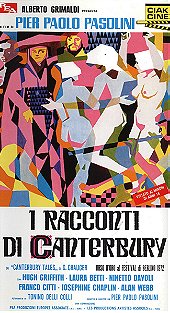You know, I’ve tried to take a few days to think about what I experienced while viewing The Canterbury Tales, and I’m still slightly at a loss for what it all added up to. It carries over the anthology structure from Chaucer, and writer-director Pier Paolo Pasolini cast himself as Chaucer, essentially writing its own director-as-auteur thesis for those inclined to lean on that critical school of thought. Since it carries over this anthology structure, The Canterbury Tales is all peaks and valleys, sometimes transcendent in its examination of a joy or a disturbed series of images, other times it rests heavily on bodily humor and naked (typically youthful, dewy and pretty young males) parts for shock value before culminating in a particularly blasphemous bit of provocation.
What does it all add up to? Hell if I know, and I’ve read my fair share of Chaucer’s stories. Thanks fancy college education for that. Anyway, back to the business at hand, Pasolini chose eight tales to adapt for this film, leaning hard on ones that allow him to indulge in ribald humor, bodily functions, lustful yearnings, and scads of naked flesh on parade. Props to him for demonstrating a vision of the rural English countryside that’s unclean, in every sense of that word.
And while much of the film doesn’t add up to much or seem to be building to anything, there’s two standout episodes. Ninetto Davoli stars in one, which sees Pasolini remaking his lover/muse/star into a variation of Chaplin’s Tramp character with surprisingly solid results. Anyone tackling Chaplin’s Tramp faces a large hurdle, how does one incorporate the various tics and mannerisms of the Tramp without appearing to be doing an exaggerated game of charades? Well, Davoli gets to be lustier, talk, and be dumber than the Tramp, which helps. It’s clearly a character built on the Tramp’s foundation, but spun out into a unique direction.
The second is the film’s big finish. A vision of Hell, that’s equally horrifying as it is blasphemous and uproarious. Demons rape and whip members of the clergy, and a giant red devil farts out corrupt monks. The audacity of the images won me over, Pasolini spared no expense in going there. If you don’t for a second think that Pasolini didn’t stick his camera square at the red devil’s anus as it expands to project the monks out, you’d be highly mistaken. It’s both very funny, and very queasy.
But then it just ends. I’m not sure where this was supposed to be leading towards, or if the film was just trying to build up to this crazed climax, but it feels unfinished. Almost as if Pasolini lost interest in making the film, and just decided to end with this provocation and move on. The Canterbury Tales is a good effort, but it could have been a great one if it had a clearer vision of purpose. This was my first Pasolini, and it made me curious about what the rest of his films were like.
 Login
Login